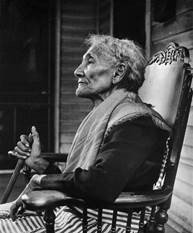A new exhibition featuring the work of renowned photographer, writer, poet, musician and composer Gordon Parks will open at the Syracuse University Art Museum on Aug. 22 and be on view through Dec. 10.

Gordon Parks, “Mrs. Jefferson,” from the series Fort Scott Revisited (Photo courtesy of The Gordon Parks Foundation)
“Homeward to the Prairie I Come” features more than 75 of Parks’ images, examining his wide-ranging artistic ideas. The exhibition not only includes Parks’ documentary photography such as the series Paris Fashions, Fort Scott Revisited and The Redemption of the Champion (featuring images of Muhammed Ali), but also his thoughts on photography as a fine art medium and his engagement with celebrated paintings and sculptures.
Most significantly, the photographs instigate cultural change by challenging viewers to imagine a more inclusive culture than the one they know: a world where Black skin represents ideal beauty, where an African American athlete embodies the exemplary hero and where an artist of African heritage has a place within the lineage of excellent artists in Western art history.
“This exhibition leverages the power of art to catalyze dialogue about the wide range of issues that Parks engaged with in his photography, from systemic racism to the labor and ethics of the global fashion industry to ideas of celebrity and home,” says Melissa Yuen, the museum’s interim chief curator.
Interim director of the museum Emily Dittman says, “Gordon Parks was a visionary interdisciplinary artist whose work had a lasting impact on the world. His dedication to continually tell the stories of individuals that were—and still are—too often hidden and overlooked is clearly evident and inspiring throughout his artistic work.”
In this spirit, the museum is taking steps to creating an accessible, diverse and multilingual space for all communities and families. The interpretive text in the exhibition is bilingual, providing both English and Spanish text for visitors, large-type text will be available and a family guide is provided to help youth and families explore the exhibition. An open access digital exhibition catalog for the exhibition will be available for visitors in the reflection area, as well as reading materials on Gordon Parks and his multifaceted career. The exhibition will be accompanied by a dynamic slate of public programming, all free and open to the public.
Co-curated by Aileen June Wang, Ph.D., curator, and Sarah Price, registrar, at the Marianna Kistler Beach Museum of Art, Kansas State University, the tour is organized by Art Bridges. The exhibition and related programs have been made possible by generous support from Art Bridges, the Wege Foundation and the Humanities Center (Syracuse Symposium).
About the Artist
Parks, one of the greatest photographers of the twentieth century, was a humanitarian with a deep commitment to social justice. He left behind an exceptional body of work that documents American life and culture from the early 1940s into the 2000s, with a focus on race relations, poverty, civil rights and urban life. Parks was also a distinguished composer, author and filmmaker who interacted with many of the leading people of his era—from politicians and artists to athletes and celebrities.
Born into poverty and segregation in Fort Scott, Kansas, in 1912, Parks was drawn to photography as a young man when he saw images of migrant workers taken by Farm Security Administration (FSA) photographers in a magazine. After buying a camera at a pawn shop, he taught himself how to use it. Despite his lack of professional training, he won the Julius Rosenwald Fellowship in 1942; this led to a position with the photography section of the FSA in Washington, D.C., and, later, the Office of War Information (OWI). Working for these agencies, which were then chronicling the nation’s social conditions, Parks quickly developed a personal style that would make him among the most celebrated photographers of his era. His extraordinary pictures allowed him to break the color line in professional photography while he created remarkably expressive images that consistently explored the social and economic impact of poverty, racism, and other forms of discrimination.
Featured Events
- Opening Reception and Keynote—Sept. 6, 4-6:30 p.m.; keynote: 4-5 p.m., 160 Link Hall; reception: 5-6:30 p.m., Syracuse University Art Museum
- The Duke Ellington Orchestra presented in partnership with the Malmgren Concert Series—Sept. 22, 4 p.m.; Hendricks Chapel, with reception to follow at the Syracuse University Art Museum
- Community Screening of “Shaft” (1971), directed by Gordon Parks—Oct. 4, 7 p.m.; The Westcott Theater, 524 Westcott St., Syracuse
- Community Day—Oct. 5, noon-4 p.m.; Syracuse University Art Museum
- Art Break: Gordon Parks with Nancy Keefe Rhodes—Oct. 16, noon; Syracuse University Art Museum
- Celebrating the Legacy of Gordon Parks—Nov. 9, noon-4 p.m.; Syracuse University Art Museum; 1 p.m.: Art Break with contemporary photographer Jarod Lew; 2:30 p.m.: screening of “A Choice of Weapons: Inspired by Gordon Parks” (2021)
- Gordon Parks Community Gathering/Showcase—Dec. 7, timing TBD; Deedee’s Community Room, Salt City Market, 484 S. Salina St., Syracuse
Visit the museum’s website for event information. Members of the media may contact Emily Dittman, interim director of Syracuse University Art Museum, for more information or to schedule a tour.
[Featured image: Gordon Roger Alexander Buchanan Parks, “Mrs. Jefferson,” from the series Fort Scott Revisited, 1950, printed in 2017, gelatin silver print, 20 x 16 inches. Kansas State University, Marianna Kistler Beach Museum of Art, gift of Gordon Parks and the Gordon Parks Foundation, 2017.373. Image courtesy of and copyright by The Gordon Parks Foundation]






